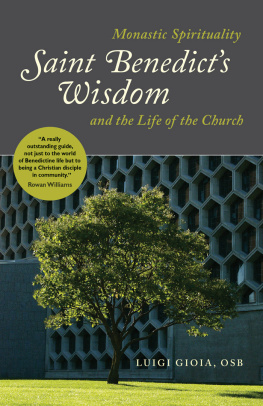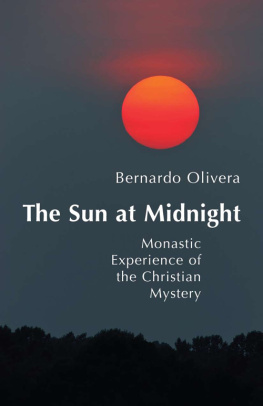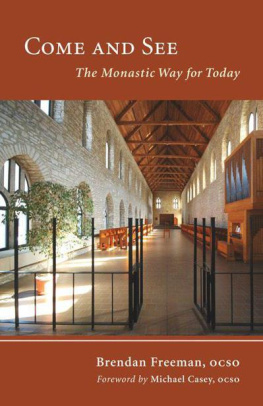Driscoll asks some thoughtful questions, and A Monks Alphabet will appeal to readers who have always wanted an unedited peek inside a monks head.
Publishers Weekly
With 187 entries ranging from paragraphs to pages of reflections and meditations, Jeremy Driscoll elicits both smiles and tears in these gems from A Monks Alphabet.
The Oregonian
A Monks Alphabet calls forth the readers ardor, breadth of spirit, curiosity, devotion, and envy of the life well lived, the thing well made.
Paul Elie, author of The Life You Save May Be Your Own: An American Pilgrimage
A rare peek into the world of a committed monk who knows how to have fun with his ABCs. His alphabet will help you find the words of your own religious experience and search for God.
Edward L. Beck, author of God Underneath: Spiritual Memoirs of a Catholic Priest
From the time of the desert fathers to our own post-Christian age, the literature of monastic wisdom has provided inspiration for those of us who lead ordinary lives in the world. Father Jeremy Driscoll, a poet and theologian who is also a Benedictine monk, brings the genre into the twenty-first century with this exquisitely written collection of reflections on life from a monastic perspective. Whether reflecting on the details of the cloistered life, or observing the weirdness of American culture, explaining a fine point of Catholic theology to a child, or meditating on the flight of a seagull over the glittering ocean at sunrise, Fr. Jeremys voice both enchants and provokes us to further contemplation. The 187 meditations are arranged by short titles in alphabetical order to emphasize that the reader should approach them in random fashion, without preconceived ideas, in order to be open to where they lead the heart and mind.
JEREMY DRISCOLL, O.S.B., is a priest and monk of Mount Angel Abbey, St. Benedict, Oregon. He is a professor of theology at Mount Angel Seminary and at the Pontifical Athenaeum Sant Anselmo in Rome. He is the author of several books of theology and poetry.
Sign up to learn more about our books and receive special offers from Shambhala Publications.

Or visit us online to sign up at shambhala.com/eshambhala.
A MONKS ALPHABET

Moments of Stillness in a Turning World
JEREMY DRISCOLL, O.S.B.

NEW SEEDS
Boston
2013
NEW SEEDS BOOKS
An imprint of Shambhala Publications, Inc.
Horticultural Hall
300 Massachusetts Avenue
Boston, Massachusetts 02115
www.shambhala.com
2006 by Jeremy Driscoll
All rights reserved. No part of this book may be reproduced in any form or by any means, electronic or mechanical, including photocopying, recording, or by any information storage and retrieval system, without permission in writing from the publisher.
THE LIBRARY OF CONGRESS CATALOGUES THE PREVIOUS EDITION OF THIS BOOK AS FOLLOWS:
Driscoll, Jeremy, 1951
A monks alphabet: moments of sillness in a turning world/ Jeremy Driscoll.
p. cm.
Originally published: London: Darton, Longman & Todd, 2005.
eISBN 978-0-8348-2642-7
ISBN 978-1-59030-373-3 (hardcover: alk. paper)
ISBN 978-1-59030-462-4 (paperback)
1. Christian lifeMeditations. 2. Vocabulary. I. Title.
BV4501.3.D75 2006
242.6942dc22
2006000685
For Paul Murray, O.P.
who helped so much with this alphabet
and who helps so much in general
Introduction
A MONKS DAY IS VERY REGULAR. Prayer always at the same time and structured in the same way. Reading and work at the appointed intervals. Meals at the customary hour and always taken at the assigned place in the refectory. A predictable diet. Always to bed at this hour, always rising from sleep at that hour. The architectural arrangement of the monastery underlines the regularity of these monastic practices. Long corridors uniformly marked by doors to the brethrens cells and to the rooms of common living. It goes on the same one day after another, week after week, for years and years. I have been living in my monastery since 1973. Not much has changed in the way I pass my days.
This terrifying regularity is not meant to drive a person mad, though it has been known to do so. It is not even meant primarily as a form of asceticism, though it does require a certain sense of discipline. It is not a repudiation of variety as the spice of life, though at first it appears flavorless. Rather, it is designed to set the monk free on a different level of his being, and generally it accomplishes just that. Once used to the exterior routine, the monk is free to live much more readily attuned to an interior life, to a realm in which the life of the mind and the spirit holds sway. Only this can make monastic life interesting. However boring or exotic its exterior forms may appear at first glance to those who do not practice them, the exotic dimension quickly disappears for those who carry them out day after day. And yet even these dimensions retain a kind of aura for practitioner and observer alike precisely because they are the concrete forms through which one passes back and forth from one level of life to the other.
So, monastic life arranges the exterior dimensions of human existence in such a way that its interior dimensions can come more immediately to the fore. This is accomplished by establishing a thoroughgoing regularity to the exterior shape of each day. But the life of the spirit, the inner life, that emerges is anything but regular, anything but predictable. It may well be too chaotic and lead to a crash. Yet in most casesguided by the wisdom embodied in a vast tradition handed down by monks of former generationsthe interior life that unfolds produces a variety that is indeed the spice of life. What people see outwardly of a monks life might lead them to expect that things would be different, that a monks inner life would be dull and plain. With this book I want to testify, Not for me it isnt! With this book I want to share some of my life, not because there is anything especially interesting about me, but because the life of the mind and spirit is interesting. I feel the privilege of being able to live in such a way. And I want to bear witness to it.
This book is not a treatise on monastic life; it does not attempt to explain it. And indeed the very form I have chosen for sharing my thoughts is a kind of anti-treatise. I am employing here a genre of thought with a precedent in both ancient monasticism and ancient philosophy. This genre has been employed for millennia, from the philosopher-emperor Marcus Aurelius to the brilliant monastic theologian Evagrius Ponticus, to a figure who in some ways combines the spirit of both of these, Blaise Pascal. Those lovers of wisdom from long ago, chose, among other ways, to express their thoughts and insights in short, provisional essays varying in length from, say, three lines to several hundred. They were written to provoke thought in an interlocutor, the reader. The reader joins the search. No one has the definitive insight, the complete statement, the total resolution of the mystery. We proceed in fits and starts, bits and pieces. But by going and going on, we get somewhere. We have at least this much satisfaction: We are not sitting still before the mystery of life; we are not paralyzed by it.
What I present here is full of starts and stops. The genre allows for it. It allows thoughts on many different levels to follow one after another in no particularly significant order, the way thoughts usually unfold in our own minds. But when we intentionally employ an exercise that lets our thoughts move in this way, we discover all sorts of unexpected connections between what is, at first glance, a series of disjointed thoughts. The many and varied thoughts come together and begin to sketch certain patterns, not created by ourselves trying to remain in control, but formed from a deeper logic which has slowly revealed itself through the thoughts being allowed to flow freely and to touch unpredictably.
Next page












